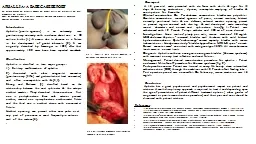

REPORT Dr Nilesh Guru Dr Kshitiz Ranka Dr Nikhil Patil Dr BSPatil Dr VS Kundargi Dr SBPatil Dept of Urology Shri B M Patil Medical College and Hospital Research Centre ID: 908354
Download Presentation The PPT/PDF document "APHALLIA : A RARE CASE" is the property of its rightful owner. Permission is granted to download and print the materials on this web site for personal, non-commercial use only, and to display it on your personal computer provided you do not modify the materials and that you retain all copyright notices contained in the materials. By downloading content from our website, you accept the terms of this agreement.
Slide1
APHALLIA : A RARE CASE REPORTDr. Nilesh Guru, Dr. Kshitiz Ranka, Dr. Nikhil Patil, Dr. B.S.Patil, Dr. V.S. Kundargi, Dr. S.B.PatilDept. of Urology, Shri B M Patil Medical College and Hospital Research Centre, Vijayapur ( Karnataka)
Case report A 16 year old male presented with c/o fever with chills & rigor for 15 days & burning micturation , dysuria, incomplete emptying of bladder & constipation for 6 months. Clinical examination: On Per abdomen examination bladder was palpalble . Genitalia examination revealed agenesis of penis, normal scrotum, bilateral normally positioned testis & vas deferens, external meatus opening present in perineal region covered with skin tag & well developed male secondary sexual characters and normal anal sphincteric tone(fig 1. Patient was catheterized with 12 French Foleys catheter and 400 ml of urine drained Investigations: Urine routine- plenty pus cells; serum creatinine- 3.8 mg/dl.. USG abdomen & pelvis - increased bladder wall thickness with mild bilateral hydroureteronehrosis. Cysto-urethroscopy- normal capacity bladder with severe trabeculations . Urodynamic study- bladder hyporeflexia. MRI LS spine - normal. Buccal mucosa smear- consistent with male genotype 46XY. All serum hormone levels were in normal limits Diagnosis: Aphallia with non neurogenic neurogenic bladder (Hinman syndrome) with recurrent urinary tract infection and renal failure . Management: Patient denied reconstructive procedure for aphallia . Patient underwent Mitrofanoff procedure for Hinman syndrome (fig 2). Postoperative course: Patient was trained in every 4th hourly clean intermittent catherterization (CIC) through the umbilicus with 10 French infant feeding tube . Post operative period was uneventful. On follow up, serum creatinine was 1.6 mg/dl. Conclusion Aphallia has a great psychosocial and psychosexual impact on patient and relatives. A multidisciplinary approach is required to treat it and depending upon the age of presentation of patient different treatment options ( either gender re-assignment or penile reconstructive procedure) and their pros and cons should be discussed with patient relatives References[1] W.O. Kessler, A.P. McLaughlin 3rd, Agenesis of penis. Embryology andmanagement, Urology 1 (1973) 226 229.[2] J.E. Wittkopf, C.S. Cooper, C.E. Hawtrey, Penile agenesis with a separatedscrotum and normal renal function in an identical twin, J. Urol. 167 (2002)687–688[3] T. Aköz, B. Erdo˘gan, M. Görgü, M.R. Kapucu, E. Kargi, Penile reconstruction inchildren using a double vascular pedicle composite groin flap, Scand. J. Urol.Nephrol. 32 (1998) 225–230.[4] C.J. Stolar, E.S. Wiener, T.W. Hensle, M.L. Silen, K. Sukarochana, W.K. Sieber,H.R. Goldstein, J. Pettit, Reconstruction of penile agenesis by a posteriorsagittal approach, J. Pediatr. Surg. 22 (1987) 1076–1080.[5] S.J. Skoog, A.B. Belman, Aphallia its classification and management, J. Urol.141 (1989) 589–592.[6] T.A. O’Connor, M.L. LaCour, E.R. Friedlander, R. Thomas, Penile agenesisassociated with urethral and bilateral renal agenesis, Urology 41 (1993)564–565.
IntroductionAphallia (penile agenesis) is an extremely rare genitourinary anomaly with incidence about one in 30 million births [1] .It occurs due to absence or a failure in the development of genital tubercule [2]. It was originally described by Imminger in 1853, after that approximately 100 cases have been reported worldwide. ClassificationAphallia is classified in two major groups . 1). Solitary malformation of aphallia. 2). Associated with other congenital anomalies (genitourinary (54%) and gastrointestinal tract anomalies) and often incompatible with life [3,4]. Skoog and Bellman [5] classified based on the relationship between the anal sphincter & the ectopic urethral meatus . They described three variations : first one is postsphincteric form with anterior perianal urethra, second one is presphincteric urethrorectal fistula and the third one is urethral atresia with vesicorectal fistula. Urethral opening can present either over pubis or at any part of perineum or most frequently in anterior wall of the rectum [6]..
Fig 1:
aphallia
with urethral opening in perineum and covered with skin tag
Fig 2:Mitrafanoff procedure (
anastamosing
appendix to urinary bladder)